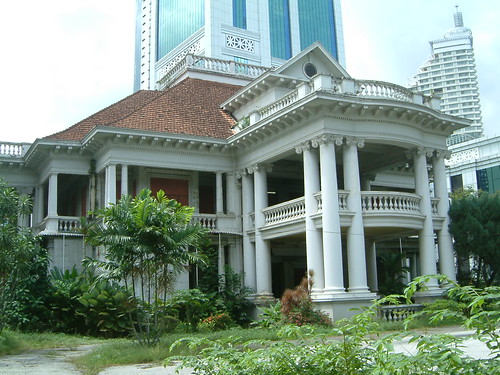“Its name means “Estuary of Mud,” and it started life as a tin-mining frontier town in the 1850s. Perhaps that is why Kuala Lumpur has always been reinventing itself. Since independence in 1957, the
capital of Malaysia has been striving to rise, like a lotus flower, above its murky, terrene origins. And it has succeeded. Today, one of the most spectacular sights in the city—or anywhere in the world—is the 88-story
Petronas Twin Towers. Lit up at night, they glitter like a pair of diamond-encrusted ears of corn. But whenever I see them, I think also of Bok House, a mansion 10 minutes’ walk from the Twin Towers.
 |
The Bok House, home to Le coq d'or restaurant, which Tan's
family patronised in his childhood. The building has been
demolished. As noted in the article: “As Kuala Lumpur has
modernized, parts of its history have been forsaken.”
According to the Wikipedia article on Bok House, the plot of
land where it once stood is now used as a temporary car park. |
Chua Cheng Bok built the mansion in 1929. He started out poor, but became one of the richest men in the country and constructed his home in the
Renaissance style, incorporating Chinese and Anglo-Indian elements into its design. In 1958 it was leased to a restaurant called Le Coq d’Or. In the early 1980s, when I was 10 or 11, my parents used to take my sister and me for dinner there once a month. Le Coq d’Or’s menu was Western: fish and chips, chicken chop, steak, but Malaysianized (the chicken chop came soaked in a mushroom gravy; the vegetables were steamed but still crunchy). The staff was Hainanese, of the kind much sought after as cooks by the English during colonial times.
On every visit I would wander around the poorly lit mansion. The lobby was tiled in squares of black and white. Italian marble statues covered in a skin of dust posed on heavy traditional Chinese blackwood furniture. A grand staircase with art nouveau cast-iron railings rose from the center of the lobby into the darkness of the closed-off second floor. The dining room smelled of starched tablecloths and stale frying butter. Oil paintings, murky with age, hung on the walls. Part of the thrill of exploring the house was my suspicion that it was haunted. Going to the washroom on one of my first visits, I turned down the wrong corridor and came to a room furnished with only an immense Chinese blackwood opium divan. The mother-of-pearl decorations on its headboard were elaborate and eerie, giving the divan a malevolent air.”


No comments:
Post a Comment